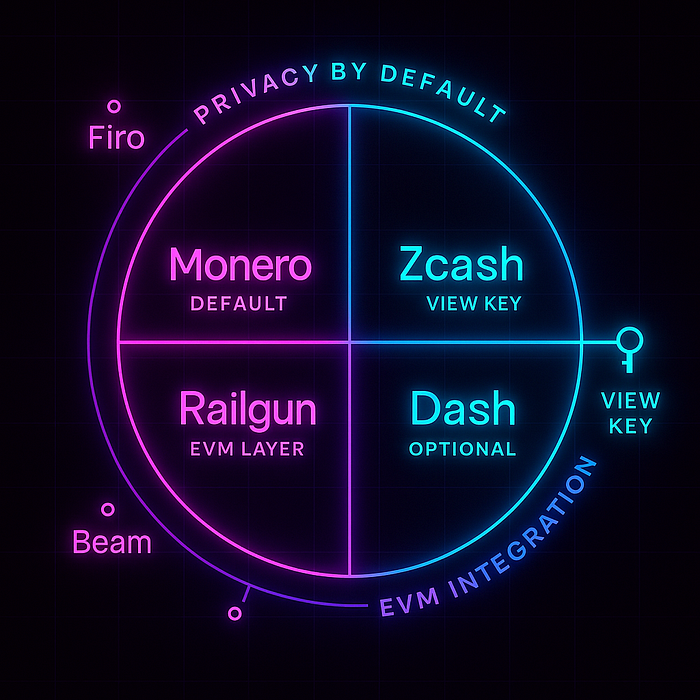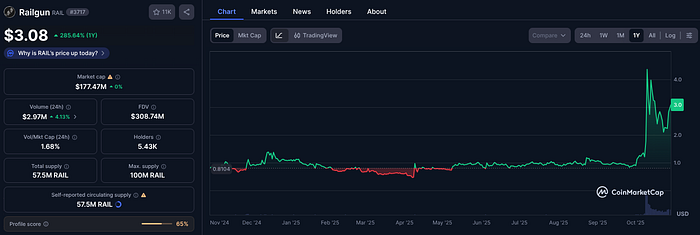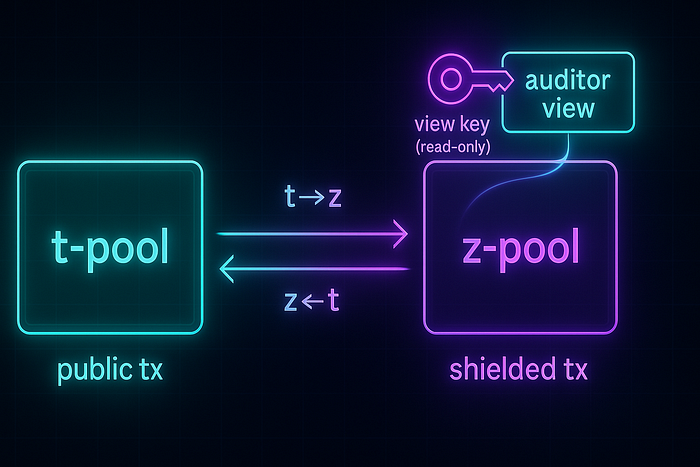The Rise of Private Blockchains: Why It Could Change The Crypto World

For years, privacy in crypto sat on the sidelines. Bitcoin was designed as a fully transparent ledger, easy to analyze; many chains that followed either kept that ethos or were more centralized and controlled. Against that backdrop, demand emerged for anonymous, decentralized money.
Broadly speaking, privacy lived on the fringe: some saw “private coins” as tools for hackers, others as a basic right not to broadcast your balance to the entire internet. Now the topic is moving back to center stage — and not by accident.
“Private money” spans different chains and designs. Monero encrypts transactions by default. Zcash lets you choose how transparent you want to be and even share viewing access via special keys. Solutions like Railgun bring familiar DeFi workflows — swaps, farming — without turning every action into a public storefront.
(See also: How Anonymous Is Blockchain?)
If privacy chains once drew most of their usage from the gray market, that picture has changed. Modern tracing and analytics can map token provenance, unpack wallet structure, and sometimes even deanonymize owners.
For everyday users, private money equals peace of mind: not every transfer has to become someone’s dossier. For businesses, it’s the ability to pay, settle, and negotiate without exposing commercial details.
In recent months, cleaner, more compliant ways to get exposure have appeared alongside more convenient venues to trade. Unsurprisingly, interest has moved beyond a niche crowd and prices spiked: Zcash (ZEC) is up ~770% year-to-date, Monero roughly doubled, Dash ~+111%, and so on.
In this piece, we’ll briefly map the leading players in the privacy segment, weigh the trade-offs, explain why institutions kept their distance — and why they’re taking a closer look now — and sketch how stronger privacy could reshape user behavior and overall market liquidity.
Sector map: who’s who in privacy coins

Monero (XMR)
Monero is the de-facto “standard” for on-chain privacy. Privacy is on by default: ring signatures obfuscate the sender, stealth addresses hide the recipient, and RingCT conceals amounts. The result is simple to grasp even for newcomers: mainstream analytics can’t build a usable public dossier on a Monero wallet.

Zcash (ZEC)

Zcash — the one many institutions are eyeing — lets you choose your level of transparency. Regular t-addresses are public like Bitcoin, while z-addresses hide sender, recipient, and amount. There’s also a view key: think of it as a read-only window for an auditor or a bank to verify flows without exposing everything else.
Dash (DASH): PrivateSend as an option

Here, privacy isn’t the core of the chain but an optional mixing feature. DASH has legacy name recognition from 2017–2018, yet the base ledger remains fully transparent. PrivateSend is an add-on rather than the product’s center of gravity.
Railgun (RAIL): privacy on top of EVM

Railgun provides a privacy layer for smart contracts. You can do familiar DeFi things — swaps, farming, and more — without turning every action into a public storefront. Under the hood it uses zk-proofs and stays compatible with the broader EVM ecosystem.
Firo, Beam, and others
FIRO (Lelantus / Spark) and BEAM (Mimblewimble) rely on different cryptographic designs, but they generally trade thinner: less liquidity, sharper volatility, more exchange restrictions. That doesn’t make them “worse,” it just raises price risk and the cost of getting in and out.
Quick tech snapshot
- zk-SNARKs (ZEC / RAIL): prove correctness without revealing data; supports selective disclosure (e.g., view keys).
- Ring signatures (XMR): sender is “blended” into a group; amounts hidden via RingCT.
- CoinJoin/mixing (DASH): optional mixing on top of an otherwise transparent chain.
- Mimblewimble (BEAM): compact blocks with hidden amounts; privacy baked into the protocol.
Private money’s strengths

For users, the main benefit is peace of mind. Private money doesn’t turn your payments and balances into a shop window, which lowers everyday “address risk,” unwanted scrutiny, and attempts to tie transactions to your identity. In Zcash-style systems you can share a view key with an auditor or a bank — showing the flows you need to show without opening the entire wallet. That’s not “shady,” that’s controlled transparency on request. If you trade, privacy also reduces behavioral pressure: when your wallet isn’t easily “readable,” it’s harder to front-run large transfers, copy your setups, or push you into predictable reactions. For businesses, private rails enable settlement and negotiations without exposing prices, discounts, or counterparties — protecting trade secrets and procurement strategy. And if you live in DeFi, EVM-native privacy layers like Railgun let you perform familiar actions without broadcasting every click, which lowers the “social” stress even for power users.
Private money’s weaknesses
The first downside you’ll feel is cost to transact. Exchanges in and out of private assets typically carry higher fees and wider spreads than BTC/ETH/USDT pairs, and moving size gets expensive fast. Next is availability. On many CEXs some privacy coins simply aren’t listed; where they are, you might only find one or two pairs, occasional regional delistings, or tighter I/O limits. That turns the usual “card → buy → withdraw → swap anywhere” into a multi-stop itinerary — paying fees at each hop. Third, ecosystem & UX. Monero is great for holding, payments, and mining, but it isn’t a DeFi playground. Privacy web3 stacks exist (RAIL and others), yet the menu is thinner and integrations are trickier than on mainstream EVM/L2s. That raises the learning curve: address types, opting into transparency, wallet compatibility, analytics friction. Finally, there’s the reputation/Compliance factor: even with clean usage, expect extra checks during onboarding and withdrawals — not because you did something wrong, but because providers’ processes flag privacy assets by default.
Why institutions kept their distance from private money
Regulatory uncertainty.
Until recently, big players had no clear answer to a basic question: “How do we show this to regulators and auditors?” Periodic delistings of privacy coins in different countries created a sense that rules could change “on any given Friday.” For funds, that’s toxic: you add an asset to the strategy, and the next day your main broker disables trading — now you’ve got reporting headaches and unhappy clients. The second pain point was auditability. If a protocol hides addresses and amounts by default, compliance teams don’t see a clean path to verify source of funds or portfolio flows. Tools like view keys and selective disclosure either weren’t standard or didn’t fit existing procedures, so the easy call was “skip it” rather than rewrite internal policy.
Operational hurdles.
Even for investors who liked the idea, you still needed “white-glove” rails: a licensed entry channel (trust/fund product), reputable custody with clear KYC/AML, and reports auditors actually accept. That stack barely existed. Add to that thin liquidity — higher fees, wider spreads, smaller volumes. For an institution, that’s not just price risk but reputational risk: “why is the fund’s NAV swinging on a couple of trades?” Finally, derivatives and margin infrastructure were scarce. Without perps or options, hedging and risk management are clunky. Net result: regulatory fog + awkward plumbing = high operating cost. Easier not to touch it.
What changed in 2024–2025: why interest is back
(See also: From Fringe to Mainstream: How the Financial Industry Fell in Love with Crypto)
Put simply, privacy moved from a cypherpunk niche to a practical tool. Getting exposure became easier — and more compliant. First, there are now clean doors for big money: trusts and private products for qualified investors. A direct example: in early October, Grayscale Zcash Trust reopened private placement, letting funds gain ZEC exposure without holding the coin directly and with standard reporting. That lowers compliance anxiety and makes the pitch palatable to investment committees. Second, trading infrastructure improved. ZEC perps appeared on the decentralized exchange Hyperliquid, and DEX-derivatives volumes hit records — meaning more accessible liquidity and leverage, and stronger price impulses. Third, the industry matured in analytics and compliance: selective disclosure via view keys and better address-risk scoring offer a middle ground between user privacy and banking/regulatory requirements — especially relevant for corporate payments. And there’s genuine demand: companies don’t want to broadcast counterparties, volumes, or discounts; users don’t want their wallets to be public dossiers. Layer on the Grayscale headlines and the usual influencer effect — and the sector lit up.
How privacy could reshape the crypto market
If privacy evolves from a niche slogan into a working layer, the flow of money changes. You get quiet corridors for OTC deals, treasury operations, and negotiations — without a public shop window of volumes and discounts. That lowers address-based risk and makes large wallets less predictable for crowds and MEV strategies. For everyday users, private bridges into EVM and DeFi mean the usual swaps, staking, and farming — without feeling like every click goes into someone’s notebook. Over time, liquidity can drift into private pools and tools with selective disclosure; exchanges and aggregators will start accounting for “off-display” segments of activity, and price discovery will rely less on one or two visible order books.
Institutional demand then spins up its own cycle. Once “clean” entry points appear (trust products, audited custody) plus basic hedging instruments, big money can build positions without information noise. That creates fresh pockets of liquidity — not always on mainstream CEXs, but via funds, OTC desks, and specialized venues. If UX stays simple (wallets, viewing keys, smart routing) and excess costs stay contained, privacy has a real shot at becoming background standard rather than an oddity.
Conclusion: privacy as pragmatism
Privacy is moving from ideology to utility: protecting trade secrets, enabling calm settlement, reducing address risk — while still producing auditor-ready reporting. Selective disclosure and view keys turn the false choice of “anonymous vs compliant” into a workable middle ground: institutions have legitimate rails to enter, and users don’t pay with their privacy on every action. From here, two levers decide the outcome: UX (wallet simplicity, swap routes, granting limited data access) and liquidity (spot, derivatives, and DeFi bridges). If both improve in tandem, privacy stops looking like a separate category and becomes the invisible default underpinning everyday crypto workflows.
As privacy moves from niche to norm, the next step is obvious: these assets will start showing up in curated pools and strategies on YLDX. If you want a front-row seat as private rails meet real liquidity, plug into YLDX now and follow the upcoming listings. We’ll keep it pragmatic — clean access, clear reporting, no drama. Don’t miss the wave.
Jοin: YLDX.ai
Listen To The Article

Black Friday 30%
Offer









